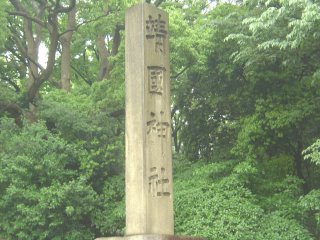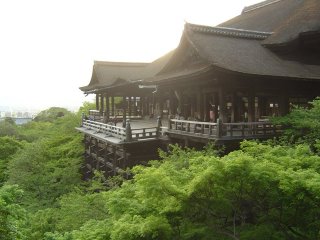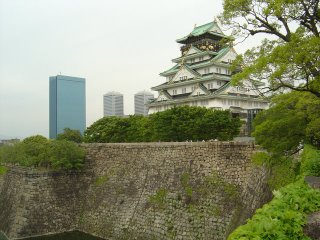31 May 2006
Kanto: Part III
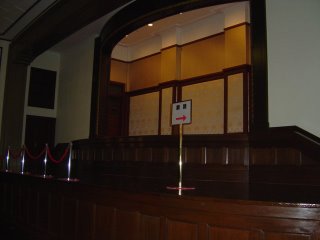
 Well for whatever reason, Firefox bastardizes my layouts that I so meticulously craft for my posts. Shikata ga nai. Anyway, I had left off with me finding myself underdressed, and visiting enshrined war criminals (when you put it like that, it makes my fashion statement seem somewhat prescient). Next and last on my list of Tokyo landmarks I visited with my class was the Boueichou (pronounched Boe-eh-cho) which translates as the Japan Defense Agency Headquarters. Located in a large sectioned off part of Shinjuku ward, the Boueichou does not exactly overpower with one massive structure ala the Pentagon, but the sprawling maze of buildings is nonetheless remarkable. We spent most of our time in one building which was the old headquarters of the Self Defense Forces (SDF). Now a museum, this building was the setting for two events any student of Japanese history would be aware of. Firstly, it housed the War Crimes Tribunals for the Far East, which consequently led to the death sentencing of former Prime Minister Tojo Hideki among others. The top photo above was the stage where the officials sat during the proceedings. The second event, reenacted to some extent in the picture was the ersatz coup d'tat and ritual suicide of famed Japanese Novelist Mishima Yukio in 1970. A right wing nationalist and aesthete that yearned to return Japan to its samurai roots, Mishima arrived at the HQ with his entourage with the pretext of paying a visit to the commandant. Once inside, he took everyone hostage, and ordered that the SDF gather outside. Once gathered, Mishima delivered a prepared speech where he attempted to incite a movement that would restore the emperor to his rightful place and return Japan to its former (albeit short-lived) glory. The reaction was not what Mishima had anticipated; jeers and mocking from the cadets. Afterwards, Mishima returned to the chamber where he committed seppuku, self disembowelment followed by decapitation. The rumor was that the man that was supposed to sever Mishima's head was his lover and couldn't cut it (literally). After a few repeated strokes, the head did roll, and another one of Mishima's entourage followed suit. Many speculate that Mishima knew that his coup would fail and it was simply a means of staging the death that he wanted for himself.
Well for whatever reason, Firefox bastardizes my layouts that I so meticulously craft for my posts. Shikata ga nai. Anyway, I had left off with me finding myself underdressed, and visiting enshrined war criminals (when you put it like that, it makes my fashion statement seem somewhat prescient). Next and last on my list of Tokyo landmarks I visited with my class was the Boueichou (pronounched Boe-eh-cho) which translates as the Japan Defense Agency Headquarters. Located in a large sectioned off part of Shinjuku ward, the Boueichou does not exactly overpower with one massive structure ala the Pentagon, but the sprawling maze of buildings is nonetheless remarkable. We spent most of our time in one building which was the old headquarters of the Self Defense Forces (SDF). Now a museum, this building was the setting for two events any student of Japanese history would be aware of. Firstly, it housed the War Crimes Tribunals for the Far East, which consequently led to the death sentencing of former Prime Minister Tojo Hideki among others. The top photo above was the stage where the officials sat during the proceedings. The second event, reenacted to some extent in the picture was the ersatz coup d'tat and ritual suicide of famed Japanese Novelist Mishima Yukio in 1970. A right wing nationalist and aesthete that yearned to return Japan to its samurai roots, Mishima arrived at the HQ with his entourage with the pretext of paying a visit to the commandant. Once inside, he took everyone hostage, and ordered that the SDF gather outside. Once gathered, Mishima delivered a prepared speech where he attempted to incite a movement that would restore the emperor to his rightful place and return Japan to its former (albeit short-lived) glory. The reaction was not what Mishima had anticipated; jeers and mocking from the cadets. Afterwards, Mishima returned to the chamber where he committed seppuku, self disembowelment followed by decapitation. The rumor was that the man that was supposed to sever Mishima's head was his lover and couldn't cut it (literally). After a few repeated strokes, the head did roll, and another one of Mishima's entourage followed suit. Many speculate that Mishima knew that his coup would fail and it was simply a means of staging the death that he wanted for himself.After that, our class dissolved into groups for a few hours before we all gathered in Shibuya for dinner and drinks at an izakaya. Around 1 am we split up for good, and I went with a friend to Roppongi for the rest of the night. The rest of my Tokyo adventures will continue later.

28 May 2006
Grabs
Kanto: Part II
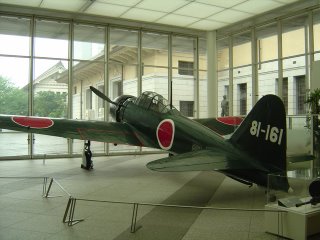
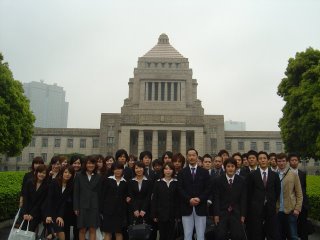 It has been about a week since my last entry; I got caught up in some shenanigans with some crazy Europeans and my art suffered for it. Anyway, since what I got up to this week does not merit further elaboration, I can continue with my own Tokyo Monogatari.
It has been about a week since my last entry; I got caught up in some shenanigans with some crazy Europeans and my art suffered for it. Anyway, since what I got up to this week does not merit further elaboration, I can continue with my own Tokyo Monogatari.After leaving the shrine part of Yasukuni, we entered the museum which is where things got a bit more eerie. I admit that we didn't really make it past the main hall and the gift shop - time and money hindered our advance. Still, I left having seen enough to convince me that the place was basically the epicenter of the resurgence of Japanese nationalism. Not only were exhibits of fighter planes from the war, there was a locomotive from the Thai-Burma railroad with a description that glossed over much of the unpleasant facts about how the road was built and why the Japanese were there in the first place. Despite all of these signs of Japan's past history of militarism - the United States is no slouch when it comes to proudly displaying its past (mis) deeds - the gift store was what really struck me as creepy. The Kyokujitsuki - the flag that represented the Japanese Imperial Navy (and currently the Maritime Self-Defense Forces I do believe) with the red rays extending from the center orb is commonly seen as a symbol of Japanese imperialism was on display. I was to somewhat relieved when many of the students I was with could not read the kanji for the name of the flag. Further, there were books questioning the Rape of Nanking and other Japanese atrocities that have been documented by numerous sources. For a moment I was ready to buy some things to show people back in Kyoto, but decided against it as I did not want to be seen as showing my support for the museum by purchasing something.
From there, we made our way to the National Diet where we took a tour of the halls of government and met with two Kyoto representatives from the House of Councilors, both members of the Democratic Party of Japan. It was quite interesting the hear about their experiences in the Diet, and to hear their views on being the opposition party. Afterwards we toured the grounds of the capitol and posed for a photograph in front. It was not my intention to bring the "casual Friday" concept to Tokyo solo, but I guess it is sort of understood that people dress to impress for these sort of things and I did not get the memo.
Next, I will talk about the Japan Defense Agency Headquarters, war crimes trials, ritual suicides and trying not the get lost in Shibuya while intoxicated and having not slept in 30 hours.

22 May 2006
Kanto: Part I

 I spent the weekend in Tokyo and the surrounding environs, my first trip to the capital in three years. I arrived on a night bus with a few other students from my seminar, and arrived well before we were scheduled to gather at the Diet Building for a tour of the Japanese legislature. After grabbing some breakfast in Shibuya, we made our way to the Yasukuni Shrine, north of the Imperial Palace in central Tokyo to see what the controversy was all about. Yasukuni represents the crux of the problem that Japan has with its neighbors in Asia, particularly China and Korea. Commemorating the souls who gave their lives in combat for the Emperor from the Boshin War prior to the Meiji Restoration of 1868 until World War II, including all the war criminals who were convicted during the International War Crimes Tribunal for the Far East - all of whom were enshrined ostensibly because they were registered as being enshrined in a seperate ceremony in 1979.
I spent the weekend in Tokyo and the surrounding environs, my first trip to the capital in three years. I arrived on a night bus with a few other students from my seminar, and arrived well before we were scheduled to gather at the Diet Building for a tour of the Japanese legislature. After grabbing some breakfast in Shibuya, we made our way to the Yasukuni Shrine, north of the Imperial Palace in central Tokyo to see what the controversy was all about. Yasukuni represents the crux of the problem that Japan has with its neighbors in Asia, particularly China and Korea. Commemorating the souls who gave their lives in combat for the Emperor from the Boshin War prior to the Meiji Restoration of 1868 until World War II, including all the war criminals who were convicted during the International War Crimes Tribunal for the Far East - all of whom were enshrined ostensibly because they were registered as being enshrined in a seperate ceremony in 1979.The Shrine itself is relatively nondescript, particularly when compared to the Meiji Shrine in Harajuku or the Heian Shrine in Kyoto. The steel torii at the entrance of the shrine perhaps symbolizes the shrine's ties to the undercurrent of militarism that has been an integral part of Japanese history up until 1945. The students I were with paid their respects at the shrine, although none of them seemed to be closet Ishihara Shintaro supporters. I declined to participate, citing apprehension to take a side of such a controversial issue at the time. We then entered the museum attached to the shrine, which was where things got a bit more blatant, and that will be the topic of the next entry...

17 May 2006
Peace in the Far East
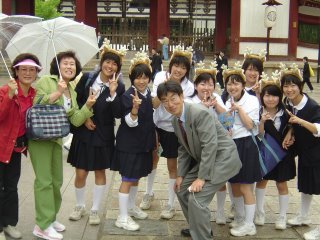 When coming to Japan you will undoubtedly be confronted with peace signs anytime you have a camera in your hands. Of all the Japanese, schools girls have probably the fastest reaction time, comparable to Billy the Kid drawing his gun and firing off a few rounds. That being said, the older women in this picture had not lost their game either. A friend of mine once asked one of his Japanese friends why the peace sign is so prevalent in photographs. His friend's response sums it up nicely: "you have to do something." And I always thought that smiling was sufficient.
When coming to Japan you will undoubtedly be confronted with peace signs anytime you have a camera in your hands. Of all the Japanese, schools girls have probably the fastest reaction time, comparable to Billy the Kid drawing his gun and firing off a few rounds. That being said, the older women in this picture had not lost their game either. A friend of mine once asked one of his Japanese friends why the peace sign is so prevalent in photographs. His friend's response sums it up nicely: "you have to do something." And I always thought that smiling was sufficient. It should be noted that Japan's Constitution is called the "Peace Constitution" not for any clause that stipulates that everyone must use the peace sign; that rule was left off the books. The "Peace Constitution" moniker comes from Article Nine which states that:
Aspiring sincerely to an international peace based on justice and order, the Japanese people forever renounce war as a sovereign right of the nation and the threat or use of force as means of settling international disputes.How long these two clauses remain is open to debate. Right now there is a push to reform the constitution and although talks have repeatedly stalled, that has not slowed down the loosening of restrictions that govern Self Defense Force (SDF) Operations. A recent article in the Economist argues these points as well and questions how these actions will affect Japan's relations with its neighbors. This much is clear: even if Article Nice remains, it will likely be relegated to an empty symbol, stripped of its meaning and purpose. Just like the peace signs in the photograph.
In order to accomplish the aim of the preceding paragraph, land, sea, and air forces, as well as other war potential, will never be maintained. The right of belligerency of the state will not be recognized.

A music review
A few weeks ago a couple friends and I went to a show in Kyoto, the highlights of which are covered in an online review on www.badbee.net. The review is titled "There's a (Teenage) Riot Goin' On" and it covers two of the five acts that played. Check it out if you are interested. Many thanks to David Hickey for the edit and rewrite, I appreciate it.
14 May 2006
Shout out!
Happy Mother's Day Mom! Love you!
(for the cynics that think this is all I did and that I just remembered: ERRONEOUS! ERRONEOUS! ERRONEOUS ON BOTH COUNTS!)
(for the cynics that think this is all I did and that I just remembered: ERRONEOUS! ERRONEOUS! ERRONEOUS ON BOTH COUNTS!)
THE CRACK, part 2
Doshisha is a private university that was founded by Niishima Jou, who actually GTFO of Japan in 1864, at the age of twenty-one, and made his way to the United States where he attended both Phillips Academy and Amherst College under the name Joseph Hardy Neeshima. In the process, Niishima became the first Japanese to recieve a college degree from a western institution. These experiences prompted Niishima to return to Japan in the wake the Meiji Restoration and found Doshisha University, a woman's college and the law school. Today, Amherst and Doshisha share close ties due to their historical ties, and are considered sister schools. The original campus of Doshisha is located on Imadegawa-dori, directly north of the Kyoto Imperial Palace. There is a second, larger campus, located south of Kyoto, but is only for undergraduate students so that is all that needs to be said about that.
My education this term consists of six classes: three Japanese language classes and three graduate level political science classes conducted in Japanese. All of my classes meet once a week for 90 minutes and up until now the homework has been less than I expected, although this is probably a good thing considering it is all in Japanese and is quite time consuming.
Kyoto was the capital of Japan from 794 to 1192 and then from 1333 until 1603 when Tokugawa Ieyasu fully supplanted the imperial family as supreme ruler of Japan and based himself in Edo - now known as Tokyo. The imperial family remained in Kyoto until the Meiji Restoration when they also moved to Tokyo. Someone on Wikipedia claims that there is still a debate as to whether Kyoto may still be the capital of Japan, but such debate is purely academic.
Today Kyoto has about 1.5 million people. The streets are arranged in a grid which makes getting lost embarrassing. The tallest building is the Kyoto Tower, a hideous structure that might have looked "modern" in a good sense for about 6 minutes in 1963 (unfortunately it was built in 1964). This is not a minority opinion either - most people claim that the views are so beautiful from the tower because being in the tower means you cannot see the tower. Japanese pragmatism at its best.
My education this term consists of six classes: three Japanese language classes and three graduate level political science classes conducted in Japanese. All of my classes meet once a week for 90 minutes and up until now the homework has been less than I expected, although this is probably a good thing considering it is all in Japanese and is quite time consuming.
Kyoto was the capital of Japan from 794 to 1192 and then from 1333 until 1603 when Tokugawa Ieyasu fully supplanted the imperial family as supreme ruler of Japan and based himself in Edo - now known as Tokyo. The imperial family remained in Kyoto until the Meiji Restoration when they also moved to Tokyo. Someone on Wikipedia claims that there is still a debate as to whether Kyoto may still be the capital of Japan, but such debate is purely academic.
Today Kyoto has about 1.5 million people. The streets are arranged in a grid which makes getting lost embarrassing. The tallest building is the Kyoto Tower, a hideous structure that might have looked "modern" in a good sense for about 6 minutes in 1963 (unfortunately it was built in 1964). This is not a minority opinion either - most people claim that the views are so beautiful from the tower because being in the tower means you cannot see the tower. Japanese pragmatism at its best.
12 May 2006
Grabs
THE CRACK, part 1
A month has already passed, and I am still settling down in Kyoto, Japan - a city that I have known and loved for over five years now. It has been a month of heartfelt reunions, formidable challenges, financial acrobats and wanton fun. I arrived the first week of April. By the end of the first week I was enrolled in not just Japanese language classes, but graduate level seminars (refferred to as ゼミ, or "zemi") which are all in Japanese. I also was introduced to my advisor, Murata Kouji, a very accomadating and friendly political science professor at Doshisha University. I am enrolled in two of his classes and am struggling to keep up, but enjoying them nonetheless.
My living situation is less than idyllic, however. Not only have I just recently gotten internet access in my room, the location is closer to "Of Mice and Men" than "Lost in Translation". Not only is the university campus over an hour away by train, downtown Kyoto is not conviently accessible and the night life in Mukaijima consists of youth street gangs (according to my former host mother), and crickets (according to my ears). Dries Durnez, an affable Belgian who has become a good friend of mine over the last month, and I are considering moving out, and finding some place closer to both the city center and our school.
End Part 1
My living situation is less than idyllic, however. Not only have I just recently gotten internet access in my room, the location is closer to "Of Mice and Men" than "Lost in Translation". Not only is the university campus over an hour away by train, downtown Kyoto is not conviently accessible and the night life in Mukaijima consists of youth street gangs (according to my former host mother), and crickets (according to my ears). Dries Durnez, an affable Belgian who has become a good friend of mine over the last month, and I are considering moving out, and finding some place closer to both the city center and our school.
End Part 1
First photo, still stalling on the substance
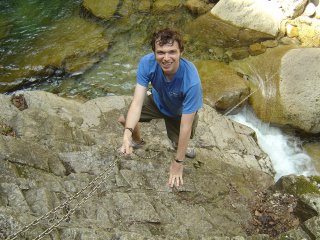 So.
So.Yeah.
This is me rappelling down some rocks, crossing a river and loving every minute of it. This was before I fell and scraped up my knee, before I became completely jaded by the hike that would never end. Or so it seemed. Now both of my hiking partners have left the Kansai region and are either gone from Japan or will soon be on their way. As for me, I am back to the grind...
By the way, I know have internet access in my room, and this blogging thing may actually start to be a viable creative outlet.

